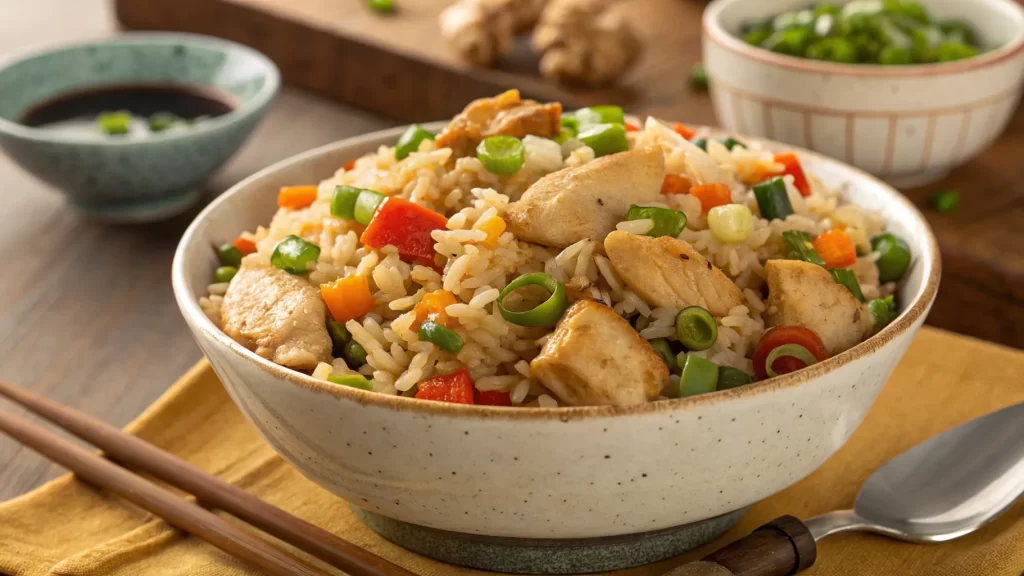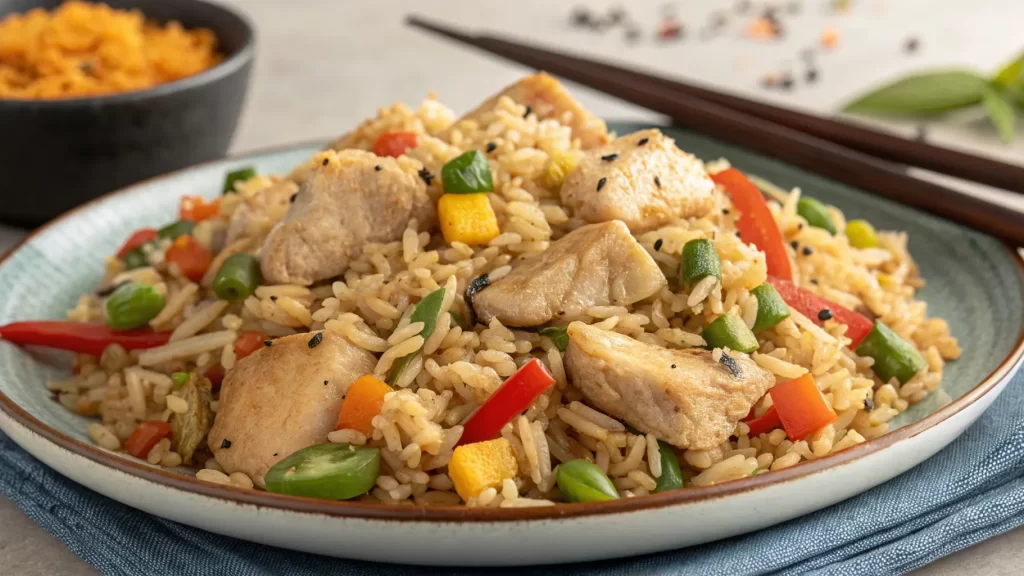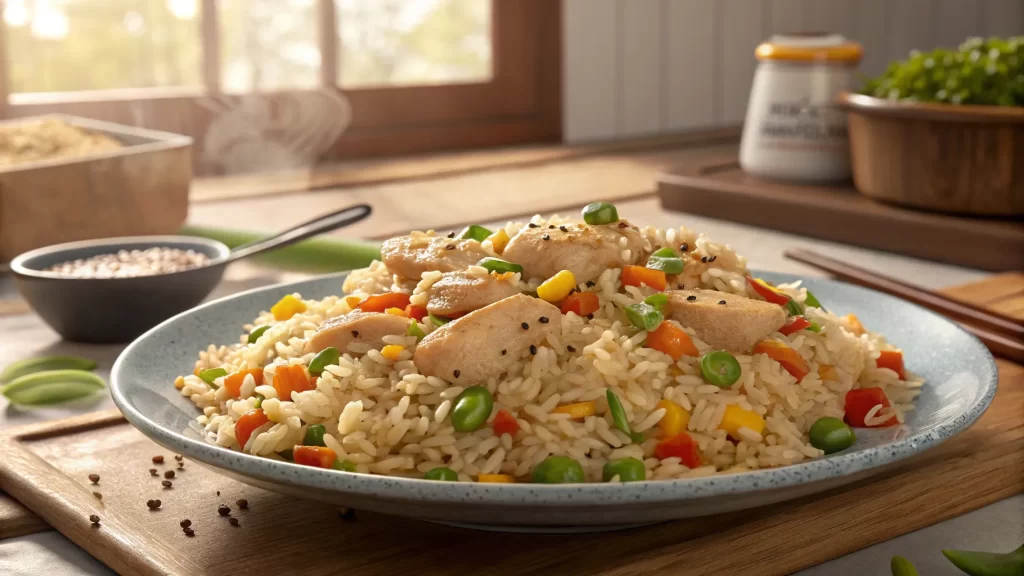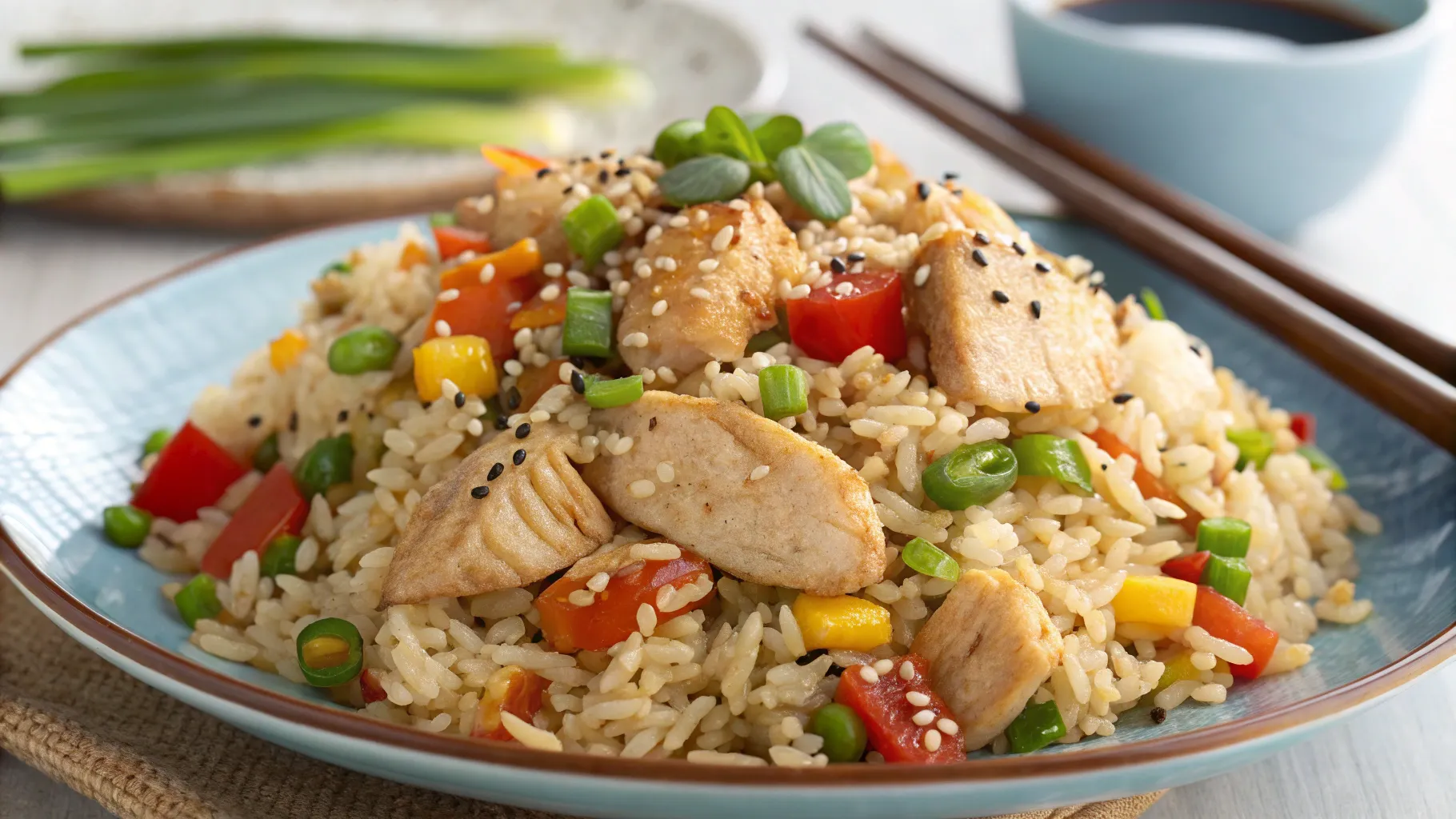Table of Contents
Chicken Fried Rice and Heart Health
What is Chicken Fried Rice?
How is chicken fried rice beneficial to the heart is a popular dish enjoyed in many cultures around the world. Traditionally, it’s made with rice, chicken, vegetables, and seasonings like soy sauce, sesame oil, and spices.
Whether it’s prepared using white rice, brown rice, or a combination of both, chicken fried rice is known for its versatility and delicious taste. It is usually made by stir-frying cooked rice with proteins, like chicken or tofu, and mixed vegetables, like peas, carrots, and bell peppers. This dish is often served as a main course, but can also function as a tasty side dish to complement other meals.
Overview of Heart Health and Its Importance
Maintaining heart health is crucial for overall well-being. The heart pumps blood, nutrients, and oxygen through the body. To support it, eat a balanced diet. This helps lower cholesterol, improve circulation, and regulate blood pressure.
Eating heart-healthy foods can reduce the risk of heart disease. These foods should be high in fiber, antioxidants, and healthy fats. Eating meals like chicken fried rice, made with wholesome ingredients, can help a heart-healthy diet.
Nutritional Benefits of Chicken Fried Rice for the Heart
Chicken fried rice can be a nutritious addition to the diet when prepared with the right ingredients. Here’s how it supports heart health:
High-Quality Protein from Chicken
Chicken is a great source of high-quality protein. It’s vital for building and repairing body tissues. It is also a lean protein when prepared with chicken breasts, making it a heart-friendly choice.
Protein maintains muscle mass and supports the immune system, which is vital for overall health. In chicken fried rice, the chicken provides essential amino acids. These amino acids help regulate cholesterol levels and support metabolic processes..
Heart-Healthy Fats from Olive Oil or Other Healthy Oils

The type of oil used in cooking chicken fried rice makes a significant impact on its nutritional value. Using heart-healthy oils like olive oil or sesame oil adds good fats. These monounsaturated and polyunsaturated fats help support heart health.
These oils lower LDL (bad) cholesterol and raise HDL (good) cholesterol. This helps prevent heart disease. Avoiding oils high in saturated fats, such as palm oil, can keep the dish heart-healthy.
Antioxidant-Rich Vegetables in Chicken Fried Rice
Vegetables are a key component of chicken fried rice, and they bring a wealth of vitamins, minerals, and antioxidants. Carrots, bell peppers, peas, and green onions are high in antioxidants. They help neutralize free radicals in the body.
Free radicals can damage blood vessels and promote inflammation, both of which are risk factors for heart disease. Adding a variety of vegetables not only boosts the flavor but also makes chicken fried rice a nutrient-dense meal for the heart.
Also Read: How to Make Fresh Squeezed Orange juice Recipe?
Whole Grains and Fiber from Brown Rice
Using brown rice in chicken fried rice is an excellent way to increase the meal’s fiber content. Brown rice is a whole grain that retains its bran, making it higher in fiber compared to white rice.
Fiber is important for heart health. It lowers cholesterol, stabilizes blood sugar, and aids digestion. Brown rice is also a rich source of B vitamins, which help regulate homocysteine levels and reduce the risk of heart disease.
How Chicken Fried Rice Supports a Healthy Heart
Chicken fried rice, when made with the right ingredients, can support various aspects of heart health. Here are a few ways it works:
Ingredients for Heart-Healthy Chicken Fried Rice
Below is a detailed list of ingredients used in chicken fried rice, along with their health benefits:
| Ingredient | Quantity | Health Benefits |
|---|---|---|
| Chicken Breasts (Boneless, Skinless) | 2 medium-sized breasts (about 400g) | Chicken breasts are a great source of lean protein, which supports muscle growth, repair, and immune function. They are low in fat, making them heart-healthy and beneficial for maintaining cholesterol levels. |
| Brown Rice | 2 cups (cooked) | Brown rice is a whole grain that retains the bran and germ, providing extra fiber, vitamins, and minerals. The fiber in brown rice helps lower cholesterol levels and supports heart health by improving digestion and reducing the risk of cardiovascular disease. |
| Olive Oil (or Sesame Oil) | 1 tablespoon | Olive oil is rich in monounsaturated fats, which help reduce bad cholesterol (LDL) and increase good cholesterol (HDL). These healthy fats support cardiovascular health and reduce inflammation, making it a heart-healthy cooking oil option. |
| Carrots (Chopped) | 1 medium carrot (peeled and diced) | Carrots are rich in vitamins A, C, and K, and are a great source of antioxidants. They help improve blood circulation, support immune function, and provide anti-inflammatory benefits for overall heart health. |
| Green Onions (Scallions) | 3-4 stalks (chopped) | Green onions are low in calories and provide a mild flavor to the dish. They are packed with antioxidants, vitamins, and minerals like vitamin K and folate, which help in maintaining healthy blood pressure and circulation. |
| Green Peas | 1/2 cup (frozen or fresh) | Green peas are an excellent source of fiber, protein, and antioxidants. They are heart-healthy due to their ability to lower cholesterol, improve circulation, and reduce the risk of hypertension and cardiovascular diseases. |
| Bell Peppers (Chopped) | 1 bell pepper (any color, diced) | Bell peppers are rich in vitamin C, antioxidants, and fiber. These nutrients promote cardiovascular health by strengthening the immune system, reducing inflammation, and supporting healthy blood vessels. |
| Garlic (Minced) | 2 cloves | Garlic has been shown to lower cholesterol, reduce blood pressure, and improve circulation. Its active compounds, like allicin, are also beneficial for heart health, acting as natural anti-inflammatory agents. |
| Eggs (Scrambled) | 2 large eggs | Eggs are a high-quality source of protein and essential nutrients. While they are relatively high in cholesterol, they contain healthy fats and can be part of a balanced diet when consumed in moderation, supporting overall heart health. |
| Low-Sodium Soy Sauce (or Tamari) | 2 tablespoons | Low-sodium soy sauce is used to add umami flavor without increasing the sodium content. This is important for controlling blood pressure and maintaining a heart-healthy diet. Tamari is a gluten-free alternative with a similar taste. |
| Sesame Seeds | 1 tablespoon (optional) | Sesame seeds are packed with healthy fats, protein, and antioxidants. They provide omega-3 fatty acids, which are known for their heart-protective properties, including lowering cholesterol and reducing inflammation. |
Improving Circulation and Blood Pressure

Peas and carrots are key vegetables in chicken fried rice. They are rich in potassium, a mineral that helps to regulate blood pressure. Potassium is essential for balancing the effects of sodium in the body and promoting better circulation. Also, the antioxidants in the vegetables reduce inflammation. This can improve blood flow and support the heart.
Strengthening the Immune System with Nutrient-Dense Foods
Chicken fried rice can be a great way to strengthen your immune system, thanks to its abundance of vitamins and minerals. The ingredients used in the dish, like green onions, peas, and bell peppers, are rich in vitamins A and C, which are essential for immune function. A strong immune system helps reduce the likelihood of infections and inflammation, both of which can strain the heart.
Also Read: How to Make Whipped Maple Iced Coffee: A Deliciously Creamy Coffee Treat
Tips for Making Chicken Fried Rice Even Healthier for the Heart
If you want to make your chicken fried rice even healthier for the heart, here are some tips to consider:
Use Lean Chicken for a Healthier Protein Source
Opt for skinless chicken breasts or lean cuts of chicken to keep the protein source low in fat. By reducing the amount of saturated fat, you can lower the dish’s overall calorie content while still getting the protein you need.
Choosing Heart-Healthy Oils
Instead of using oils high in saturated fats, choose heart-healthy oils like olive oil or sesame oil. These oils are high in unsaturated fats. They improve cholesterol and reduce inflammation. So, they promote heart health.
Adding More Vegetables for Increased Nutrients
For an even more nutrient-packed chicken fried rice, feel free to add more vegetables. Green beans, broccoli, or spinach can boost the dish’s antioxidants. They also add fiber and vitamins for heart health.
Opting for Brown Rice Over White Rice
Choosing brown rice over white rice is one of the best ways to increase the dish’s fiber content. Brown rice keeps its bran and germ. They have nutrients like magnesium and fiber. They support heart health.
Controlling Sodium Levels in Fried Rice Recipes
To keep sodium levels in check, consider using low-sodium soy sauce or tamari instead of regular soy sauce, which can be high in salt. You can also add other seasonings like garlic, ginger, and chili to enhance the flavor without increasing the sodium content.
Chicken Fried Rice Recipe Timetable
| Step | Activity | Time |
|---|---|---|
| 1 | Prepare the Ingredients | 10 minutes |
| 2 | Cook Chicken (Dice & Stir Fry) | 8 minutes |
| 3 | Prepare Vegetables (Chop & Sauté) | 7 minutes |
| 4 | Cook Rice (If Not Pre-cooked) | 15 minutes |
| 5 | Fry Everything Together | 10 minutes |
| 6 | Season and Serve | 5 minutes |
Potential Risks and Considerations

While chicken fried rice can be a healthy meal choice, there are some considerations to keep in mind:
Managing Portion Size for a Balanced Diet
As with any meal, portion control is important to maintain a balanced diet. Eating large portions of fried rice, even if it’s made with healthy ingredients, can contribute to excess calorie intake. Try to keep portion sizes moderate to ensure you’re getting the right balance of nutrients.
Avoiding Excessive Oils and Sauces
While oils and sauces are important for flavor, it’s essential not to overdo it. Excessive amounts of oil and sauces can increase the dish’s calorie and sodium content, which may not be heart-healthy. Stick to recommended amounts to maintain the dish’s nutritional balance.
Read Also: Creamy Cocoa Fruit Cup Recipe: Fresh Cacao Delights Await!
The Importance of Moderation in Chicken Fried Rice Consumption
Chicken fried rice should be enjoyed as part of a balanced diet. While it can provide important nutrients like protein, fiber, and healthy fats, it’s important not to rely on it as the sole source of your diet. Make sure to include a variety of nutrient-rich foods throughout the week.
Chicken Fried Rice as a Heart-Healthy Meal
Recap of the Heart-Healthy Benefits
Chicken fried rice can be heart-healthy. Use lean chicken, veggies, and healthy oils. Protein, fiber, and antioxidants support heart health. They lower cholesterol, improve circulation, and reduce inflammation.
Why Chicken Fried Rice Can Be Part of a Heart-Healthy Diet
Incorporating chicken fried rice into your diet can be a delicious and nutritious way to promote heart health. With the right balance of ingredients and mindful cooking techniques, this dish can fit seamlessly into a heart-healthy eating plan. Whether you’re enjoying it as a main course or a side dish, chicken fried rice is a versatile and flavorful option that nourishes the heart.

